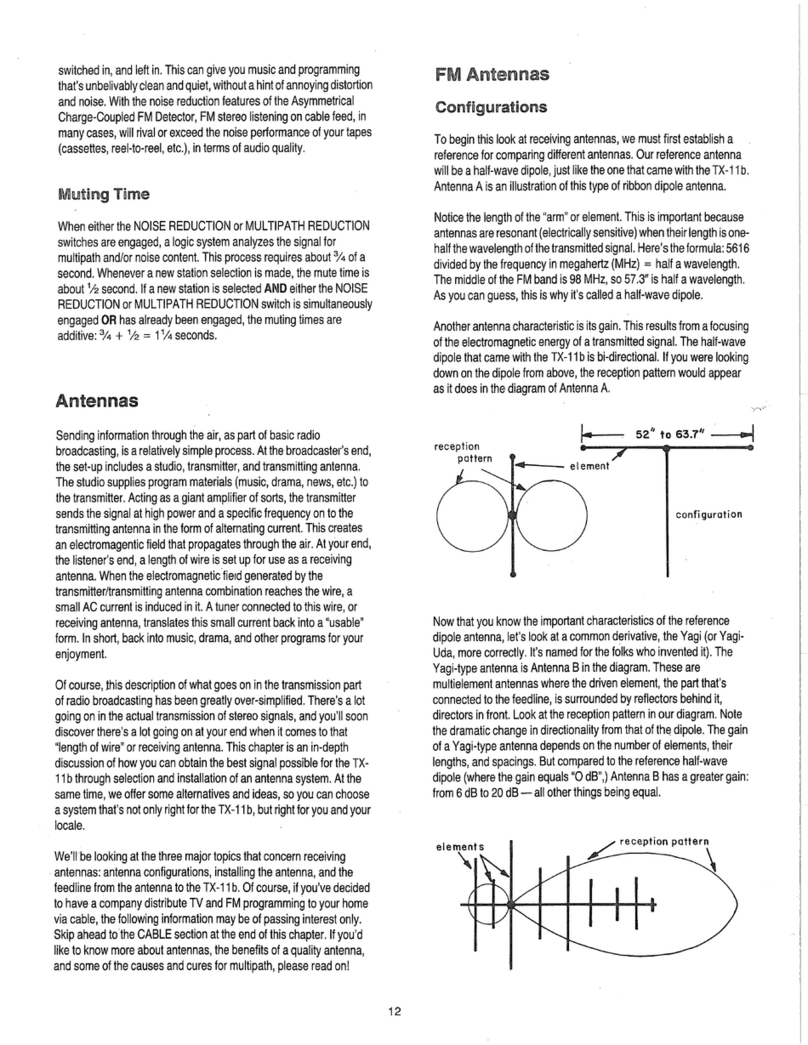
Introduction
Congratulations!You'vepurchased
the
finesttuneravailable:
the
Carver
TX-11
b
Quartz
SynthesizedStereoTunerwithAsymmetrical
Charge-Coupled
FM
Detector™
and
UltraHighFidelityWideBand
AM
stereo(utilizingMotorola's
CQUAM™
system).Your
new
tuner's
special
FM
circuitry
isBob
Carver'sbrilliantsolution
for
eliminating
the
distortion
and
noise
that
usually
make
FM
listening
a
less
than
pleasurableexperience.Whenengaged,thesepatentedcircuits
enable
the
TX-11
bto
literallypullmusicfrom
the
morass
of
hiss
and
distortionassociatedwithmultipathinterference.You'll
be
able
to
consistently,cleanly,quietlyenjoy
the
music
in
STEREO.
The
ambience
and
localizinginformationneeded
to
perceivestereo,also
lost
to
distortion,
is
restored.Finally,
a
realbreakthroughthatmakes
FM
programming
compete
equally
with
records
and
tapes
for
audio
quality,
and
share
of
yourlisteningtime.
The
TX-11
b has
beenexceptionallyengineered,
andis
superbly
crafted
for
morethansonicexcellence.Yourtuner
has
many
sophisticatedfeaturesthatwillenhanceyourenjoyment
of
stereo
listening,
now,
andinthe
future.
To
takefulladvantage
ofall
this,
be
sure
to
read
the
safety,installation,
and
operatinginstructions.We've
prepared
thisowner'smanual
for
learningabout
the
concepts,
controls,
and
functionsthatmake
the
TX-11
ba
superior
tuner
in
every
way.
We'veincludedevenmoreinformation
on
getting
the
most
from
your
new
tuner.
See
ANTENNAS,
andthe
Appendix
of
thismanual
to
ensure
youare
getting
the
verybestsound
you
deserve.
WarrantyCard
Please,
fill
outand
return
the
WarrantyCardthatcamewith
theTX-
11
b's
packing
kit.
It'shighlyunlikelyyour
TX-11
b
will
ever
need
service,
but
should
the
unlikely
occur,
yourWarrantyCard
isthe
ticket
to
Carver's
two
yearslimitedParts/LaborWarrantyrepair.Eitherfrom
a
localAuthorizedCarverServiceCenter,
orthe
factory.
We
also
suggest
you
fill
outthe
warrantyinformation
inthe
space
we
included
on
the
precedingpage.
Be
sure
to
include
any
personal
ID
number
used
in
furtheridentifying
the
TX-11
b.
Before
Going
any
Farther...
Here
are
somesuggesteddo's
and
don'tsthatwillmakesetting-up
and
using
the
TX-11
ba
safe,
as
well
as
enjoyableexperience:
•
Don'toperate
the
TX-11
b onany
other
power
linevoltageother
than
that
specified
onthe
rear
panel.
•
Make
all
connections
toand
from
the
TX-11
b
with
its
power,
and
power
forall
othercomponents
in
yoursystem,switchedOFF.
•
Unplug
the
TX-11
b's
power
and
antennalead-induringelectrical
storms,
orif
you're
not
going
touseitfora
prolongedperiod
of
time.
•
When
unplugging
theac
linecord,grasp
the
plug
and
pull;
don't
yank
onthe
corditself.
•If
someoneaccidentlyspills
a
drink
onthe
TX-11
b's
cabinet,
unplug
the
tuner
and
have
it
checked
outor
cleaned
bya
qualified
servicetechnician.Thisapplies
to
every
piece
of
equipment
in
your
stereosystem.
•Of
course,we'vementionedthattherearen't
any
user-serviceable
partsinsideyour
TX-11
b.
Please,resist
any
temptation
to
fiddle
aroundinside
the
TX-11
b.
Avoidpossibleelectricalshockand/or
extremeembarrassment.
Refer
all
servicework
toa
qualified
technician.
Again,
keep
the
carton
and
packingmaterial
the
TX-11
b
came
in.
Should
you
move,
the
best
shipping
container
isthe
original
carton.
Hang
onto
this
owner's
manual,
too.Whenyourmusicsystemgets
to
itsnew
home,
the
safety,installation,
and
programminginstructions
could
be
morethanuseful.
Also,
pleasefill
outand
return
the
warranty
card,
ifyou
haven'talreadydone
so.Inthe
remote
possibility
your
TX-11
b
everneedsrepair,
the
warrantycard
isa
passport
to
speedy,
efficientservicefromeither
a
localAuthorizedCarverServiceCenter
or
the
factory.




























